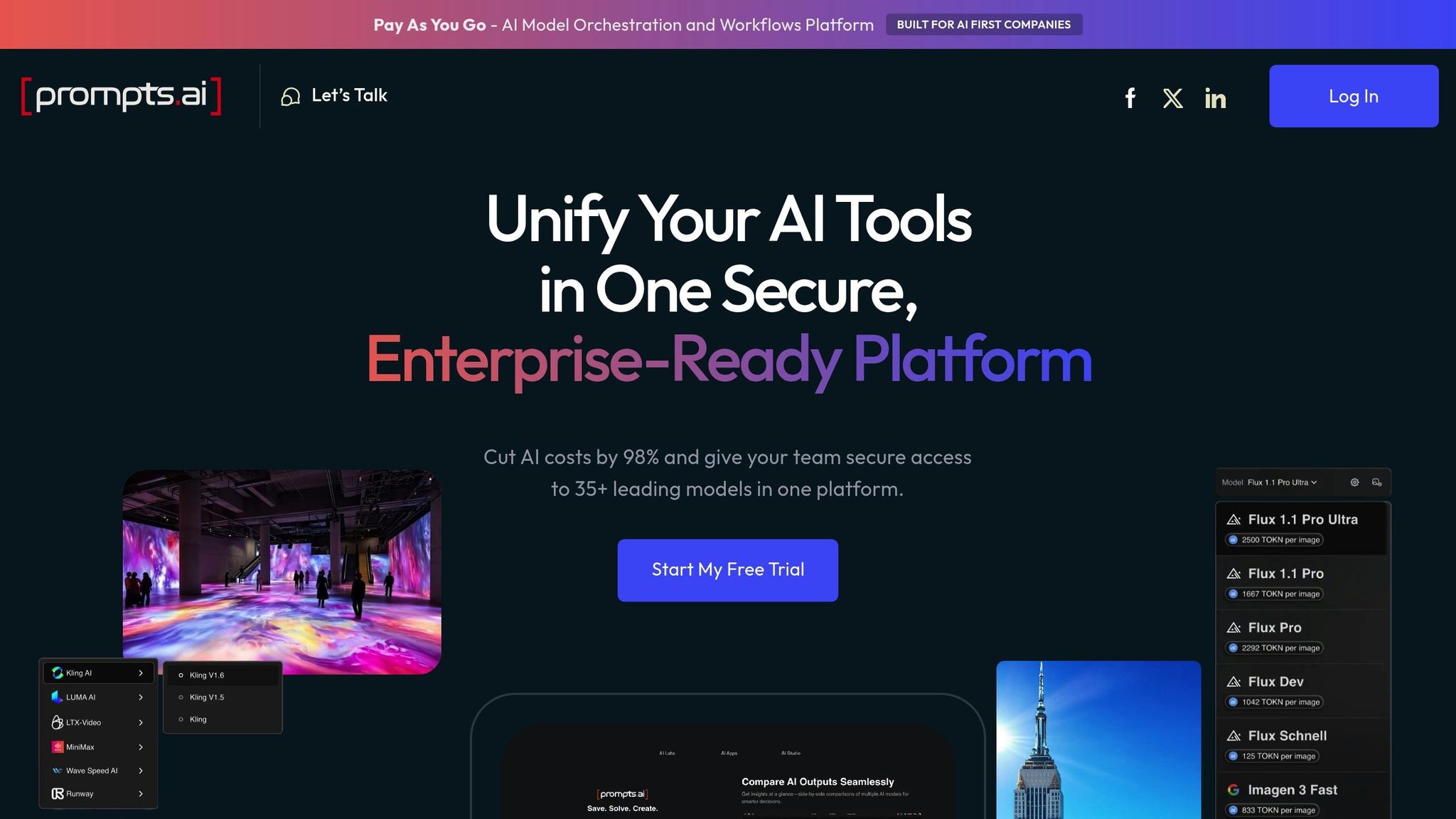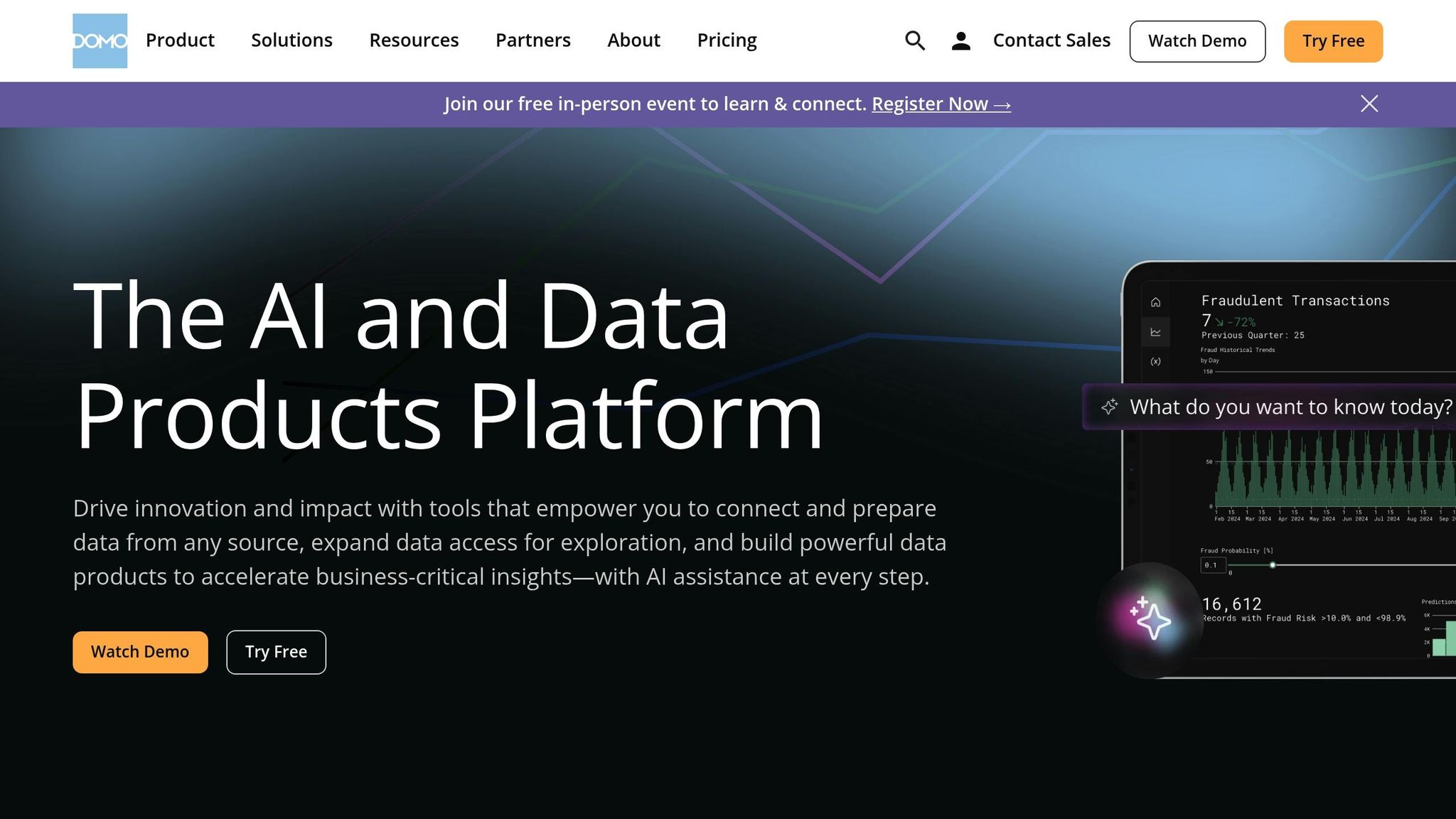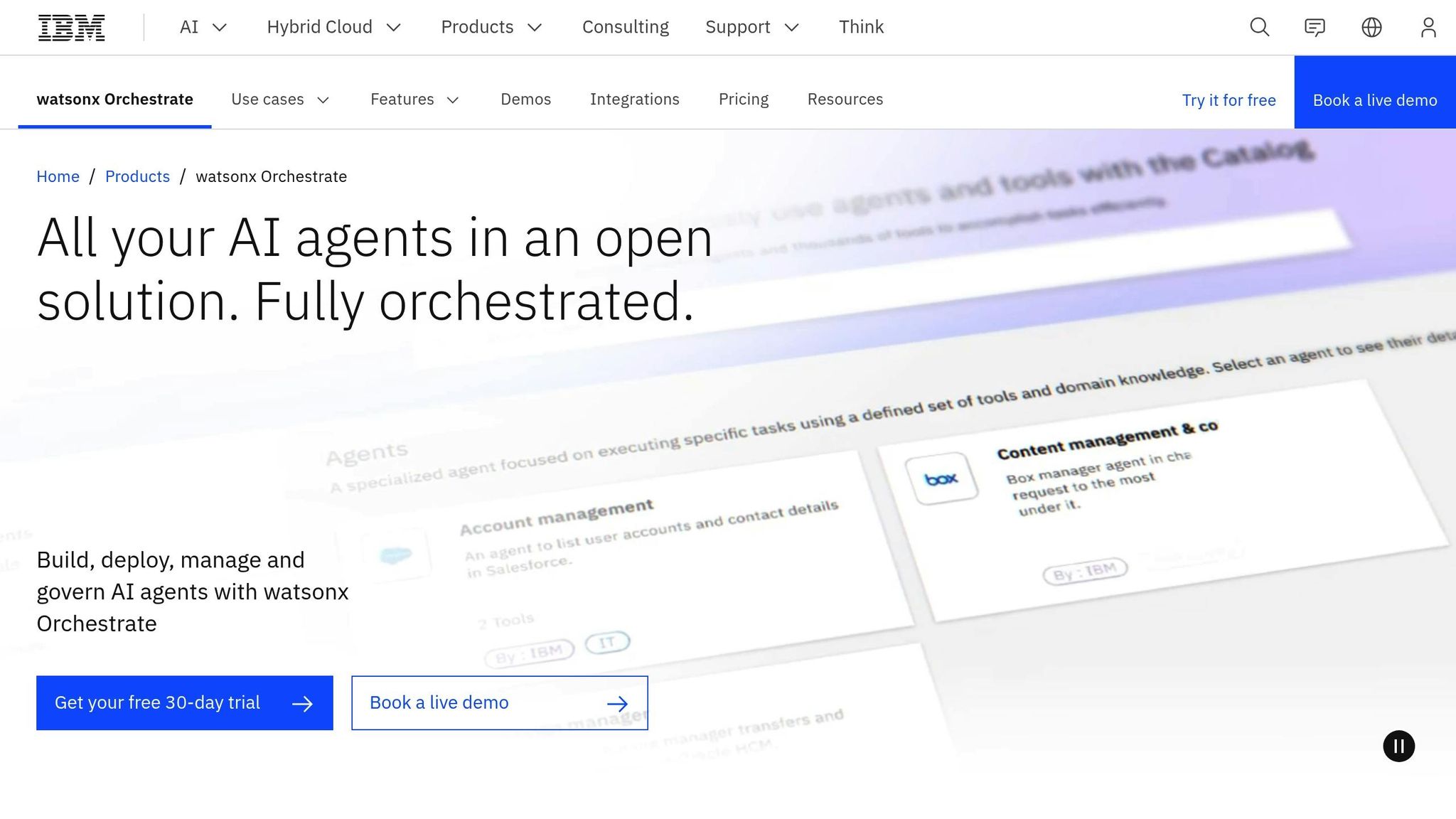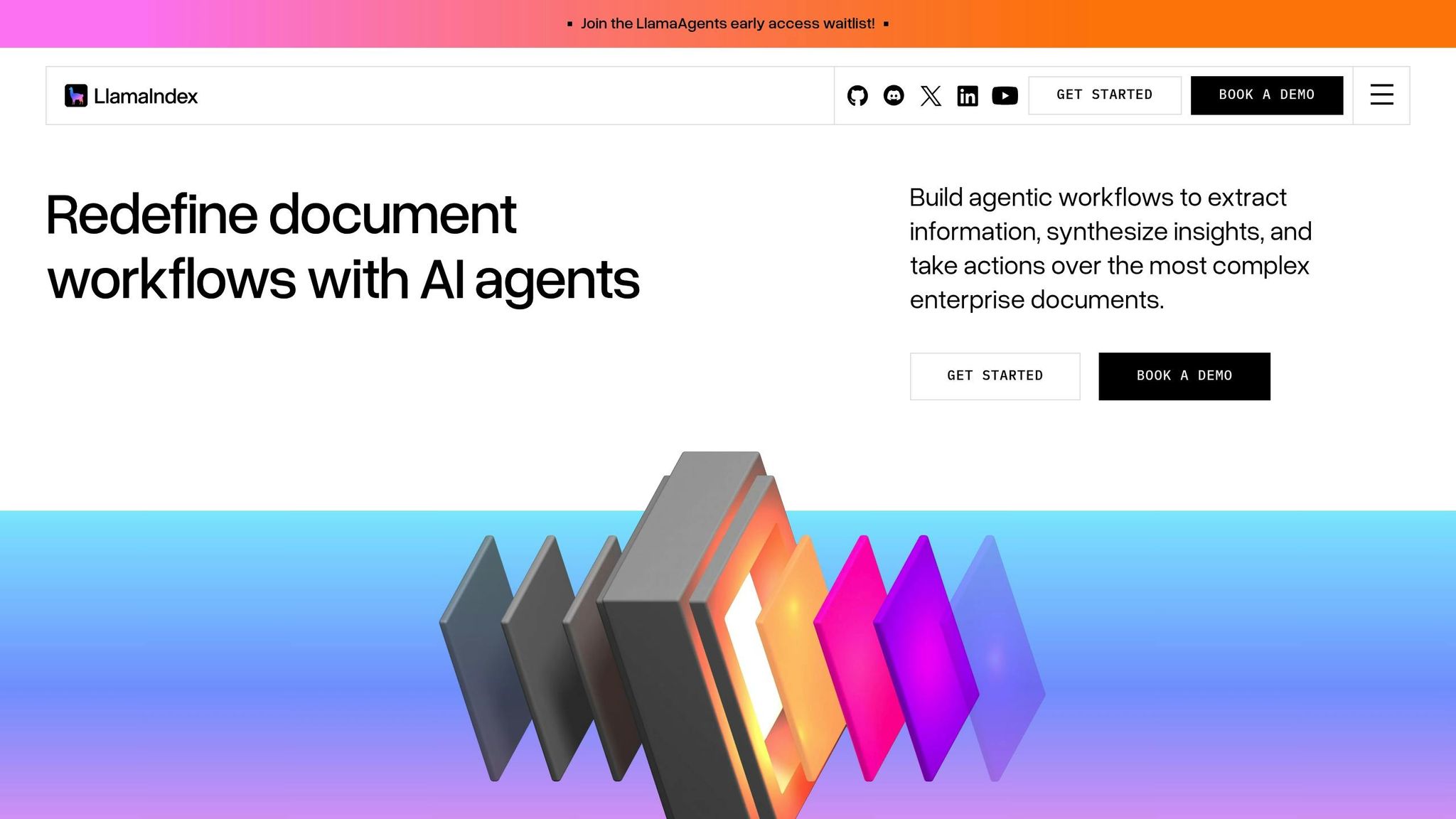
AI integration platforms are transforming how businesses operate, helping streamline workflows, reduce costs, and improve efficiency. From connecting multiple AI tools to automating complex processes, these platforms are essential for organizations aiming to stay competitive in today’s fast-paced environment. Below, we explore seven leading platforms - Prompts.ai, Domo, Apache Airflow, IBM watsonx Orchestrate, UiPath Agentic Automation Platform, LlamaIndex, and Microsoft AutoGen - highlighting their key features, strengths, and considerations.
| Platform | Key Features | Best For | Cost Model |
|---|---|---|---|
| Prompts.ai | 35+ AI models, FinOps controls | Cost-conscious AI orchestration | Pay-as-you-go |
| Domo | Real-time analytics, Magic ETL | Data-driven organizations | Usage-based |
| Apache Airflow | Open-source, Python-based workflows | Customizable AI pipelines | Free (infrastructure) |
| IBM watsonx Orchestrate | Conversational AI, compliance tools | Regulated industries | Usage-based |
| UiPath | RPA + AI, document understanding | Enterprise automation | Flexible licensing |
| LlamaIndex | Private data integration, vector search | Context-rich AI applications | Free (open-source) |
| Microsoft AutoGen | Multi-agent collaboration, scalable | Large-scale AI projects | Modular setup costs |
Choosing the right platform depends on your business size, goals, and technical capabilities. Whether you prioritize cost savings, scalability, or advanced AI features, these platforms provide tailored solutions to meet diverse needs.

Prompts.ai is an enterprise-grade AI orchestration platform that brings together over 35 leading language models, including GPT-5, Claude, LLaMA, and Gemini, all within a single, secure interface. By consolidating these tools, businesses can streamline their AI operations and maintain full control without juggling multiple systems.
Prompts.ai shines when it comes to connecting with existing business systems, thanks to its robust API integrations and pre-built connectors. The platform works seamlessly with widely used enterprise tools like CRM systems, ERP platforms, Slack, Gmail, and Trello. This allows businesses to automate workflows while keeping their current operations intact.
For example, an e-commerce company used Prompts.ai to automate order updates and respond to customer inquiries, while a financial services provider leveraged it to streamline loan processing. These changes led to a 40% reduction in response times and improved customer satisfaction. Additionally, the platform has been instrumental in resolving supply chain issues more quickly, resulting in fewer operational disruptions.
Prompts.ai supports a range of AI functionalities, including natural language processing (NLP), predictive analytics, and machine learning. Users can create tailored workflows using either a visual builder or a code-based interface, ensuring the flexibility to meet unique business requirements.
Built on a cloud-native architecture, Prompts.ai ensures consistent performance even as demand grows. Its dynamic resource allocation, multi-tenant support, load balancing, and elastic compute capabilities allow organizations to scale usage without interruptions.
Case studies highlight how businesses have expanded their use of Prompts.ai, moving from small pilot projects to full-scale, organization-wide implementations. This adaptability makes the platform suitable for both small businesses exploring AI and large enterprises orchestrating AI across multiple departments.
Prompts.ai includes comprehensive governance and compliance tools that help businesses meet stringent regulatory standards. Features like role-based access, data encryption, and audit logging ensure security while supporting compliance with regulations such as GDPR, HIPAA, and SOC 2.
The platform initiated its SOC 2 Type 2 audit process on June 19, 2025, and maintains a Trust Center at trust.prompts.ai. Here, businesses can access real-time updates on the platform’s security posture, policies, and compliance measures. With full visibility and auditability of AI interactions, Prompts.ai is especially beneficial for industries like healthcare and finance, where data privacy and security are paramount.
Prompts.ai provides flexible pricing options, including pay-as-you-go and subscription plans, allowing businesses to align their costs with actual usage. By centralizing and simplifying AI tool management, the platform helps reduce AI-related expenses.
Businesses have reported up to a 30% reduction in process costs after adopting Prompts.ai for automation. Its capabilities minimize manual labor and operational overhead, delivering tangible savings. Additionally, transparent billing and real-time usage analytics enable organizations to optimize their AI spending. FinOps cost controls offer detailed insights into token usage across various models and teams, helping prevent unexpected expenses.
Coming up, we’ll delve into Domo’s approach to AI integration, further broadening the discussion on efficient workflow automation.

Domo is a cloud-based platform for business intelligence and data visualization, now enhanced with AI-driven automation to streamline enterprise workflows. It transforms raw data into meaningful insights and supports automated decision-making throughout an organization.
Domo connects seamlessly with over 1,000 business applications, including Salesforce, HubSpot, Google Analytics, Amazon Web Services, and Microsoft Azure. These integrations enable real-time data synchronization without the need for complex configurations.
At the core of its AI capabilities is the Magic ETL tool, which automates data pipelines using predefined rules. This tool can deliver sales forecasts and trigger alerts to team members when key performance metrics dip below set thresholds. These features make Domo a strong option for organizations aiming to automate their data insights.
Built on a cloud-native architecture, Domo ensures smooth performance even during high-demand periods by automatically adjusting computing resources. This scalability supports enterprise-level data processing needs.
Large organizations have successfully implemented Domo across various departments and locations. Its multi-tenant architecture includes role-based access controls and data governance tools, allowing individual departments to manage their workflows while sharing insights across the company.
Domo offers a robust set of data governance tools, including data lineage tracking, automated quality monitoring, and audit trails. It holds SOC 2 Type II certification and includes features to support compliance with GDPR and CCPA regulations, ensuring data privacy and security.
The Governance Toolkit enforces access policies and tracks data usage, safeguarding sensitive information and providing transparency.
Domo uses a usage-based pricing model, allowing businesses to scale their investment based on actual platform use. Pricing tiers are determined by the number of users and the volume of data processed, offering flexibility for organizations of all sizes.
By automating data workflows, Domo reduces operational costs and frees up employees for more strategic tasks. Additionally, its self-service analytics tools empower business users to create reports and dashboards, easing the workload on IT teams.
Next, we’ll explore another platform that broadens the scope of workflow automation.

Apache Airflow is an open-source platform designed for developing, scheduling, and monitoring workflows, making it a key tool for orchestrating AI pipelines. By leveraging Python code, it allows businesses to build intricate workflows, seamlessly integrating AI models with their existing data infrastructure.
Apache Airflow stands out for its ability to connect diverse systems via a robust library of operators and hooks. With pre-built connectors, it integrates effortlessly with cloud platforms, databases, APIs, and machine learning frameworks.
Using Directed Acyclic Graphs (DAGs), Airflow enables businesses to define workflows that handle tasks like triggering AI model training, transferring data between systems, and performing post-processing in a precise sequence. For AI workflows, this means automating processes such as retraining models when new data arrives, deploying updated models, and tracking their performance.
The XCom feature allows tasks within a workflow to share data, enabling the smooth transfer of AI model outputs between steps. This functionality is especially valuable for creating end-to-end AI pipelines, where data moves seamlessly from preprocessing stages to model inference and result storage.
Apache Airflow is built to handle workloads of all sizes, offering multiple execution modes for scalability. With options like CeleryExecutor and KubernetesExecutor, it supports horizontal scaling and dynamic resource allocation, ensuring efficient performance even under heavy workloads.
Parallel task execution is another strength, allowing independent workflow steps to run simultaneously. This reduces processing time significantly, which is particularly advantageous for businesses managing multiple AI models or working with large datasets, where parallelization can save hours or even days.
The platform also automates backfilling, enabling the reprocessing of historical data whenever AI models are updated. This ensures data consistency across time periods without requiring manual intervention.
Apache Airflow offers detailed audit logging, tracking every task execution with records of start times, completion statuses, and error messages. This feature is critical for businesses in regulated industries, as it helps demonstrate compliance with stringent data processing requirements.
Role-Based Access Control (RBAC) adds an extra layer of security by restricting access to workflows, connections, and administrative functions. This ensures sensitive AI workflows and data remain secure, while still allowing authorized team members to manage their respective processes.
The platform's data lineage tracking provides a clear view of how data flows through AI pipelines, helping businesses identify bottlenecks, resolve issues, and maintain high data quality. Additionally, SLA monitoring alerts teams when workflows take longer than expected, ensuring timely completion of critical tasks.
As an open-source tool, Apache Airflow eliminates licensing fees, making it an appealing choice for businesses looking to implement AI workflow orchestration without a large upfront cost. The primary expenses involve infrastructure setup and personnel for management.
Efficient scheduling and task retries help reduce computational costs, allowing tasks to run during off-peak hours to save on resources.
Airflow's monitoring capabilities provide valuable insights into resource usage. Its web-based dashboard displays metrics such as task duration, resource consumption, and success rates, enabling businesses to make informed decisions about workflow optimization and infrastructure spending.
Next, we'll dive into platforms that combine enterprise-level features with advanced AI integration.

IBM watsonx Orchestrate takes workflow automation to the next level by combining conversational AI with workflow orchestration. Designed to simplify enterprise processes, this platform leverages IBM Watson’s capabilities to create an intuitive, scalable solution for automating tasks. It integrates seamlessly with existing tools and processes, making it a powerful asset for businesses looking to streamline operations.
IBM watsonx Orchestrate connects effortlessly with enterprise applications and legacy systems through pre-built connectors for platforms like Salesforce, ServiceNow, SAP, Microsoft 365, and Slack. Its conversational interface allows users to initiate workflows using natural language commands. For instance, employees can simply say, “Generate a sales report for Q3” or “Set up a customer onboarding workflow,” bypassing the need for complicated interfaces and making the system accessible to users of all technical backgrounds.
The platform’s skills-based architecture organizes AI capabilities into reusable components known as "skills." These skills combine AI models, APIs, and business logic into single, deployable units. For example, a customer service skill might integrate sentiment analysis, knowledge base searches, and ticket routing into a unified workflow, all activated with a simple command.
Built on IBM Cloud, watsonx Orchestrate is designed to handle large-scale enterprise workloads. The infrastructure dynamically adjusts computing resources to meet demand, ensuring critical business processes remain prioritized during peak times. Its multi-tenant architecture supports deployment across multiple departments while maintaining strict data isolation and security.
The platform’s workflow orchestration engine can manage thousands of simultaneous processes, distributing tasks efficiently across servers. This load balancing prevents bottlenecks and ensures fast response times, even during periods of high activity.
IBM watsonx Orchestrate offers robust governance features to ensure secure and compliant workflow management. Audit trails and role-based access controls provide transparent tracking and restrict access to sensitive AI capabilities, ensuring only authorized personnel can use them.
Data governance tools include encryption for data both at rest and in transit, along with options to mask or anonymize sensitive information within workflows. These features help businesses comply with regulations like GDPR, HIPAA, and SOX while leveraging AI for automation. Additionally, its explainable AI capabilities provide insights into how AI models make decisions, which is especially important for industries that require justification for automated processes.
The platform operates on a consumption-based pricing model, charging businesses based on usage rather than fixed licensing fees. This approach allows companies to start small and expand their investment as they increase AI adoption. Automating routine tasks reduces manual workloads, leading to significant cost savings. The conversational interface further minimizes training needs, cutting down on support expenses.
Resource optimization tools provide detailed analytics and spending forecasts, helping businesses manage budgets effectively. Alerts notify users when they approach spending limits, while pre-built skills and connectors save development time and costs compared to creating custom AI solutions from scratch.
Next, we’ll explore how robotic process automation platforms are enhanced with AI.

UiPath has advanced far beyond traditional robotic process automation (RPA), introducing agentic automation that empowers AI agents to handle complex business tasks. The UiPath Agentic Automation Platform merges RPA with advanced AI, creating intelligent agents capable of reasoning, decision-making, and adapting to dynamic conditions - all without constant human intervention. This evolution marks a new chapter in workflow automation for businesses.
The UiPath platform stands out for its ability to integrate with virtually any business application. With a vast library of pre-built connectors and activities, it easily connects to enterprise systems like SAP, Oracle, Salesforce, Microsoft Dynamics, and hundreds of other commonly used applications.
One standout feature is its AI-powered document understanding tool, which extracts data from various documents such as invoices, contracts, and forms, regardless of their format or layout. Additionally, the platform's computer vision technology allows it to interact with applications in a human-like manner, performing actions like clicking buttons, filling out forms, and navigating interfaces - even in the absence of APIs.
UiPath Apps further enhances usability by enabling employees to trigger automated workflows through custom front-end applications. For example, users can submit requests that automatically initiate multi-step processes, such as routing expense approvals, updating accounting systems, and notifying key stakeholders.
UiPath's Automation Cloud and Orchestrator ensure seamless scalability by managing thousands of automation processes. Features like dynamic load balancing and real-time monitoring help global organizations maintain cost-effective operations without sacrificing performance.
The platform supports both attended and unattended automation modes, offering flexible deployment options. Unattended bots are designed to operate continuously on dedicated servers, handling high-volume, repetitive tasks, while attended bots work alongside employees to assist with tasks requiring human input.
UiPath prioritizes compliance and transparency with features like detailed audit trails and logging that track every action performed by automated processes. Role-based access controls regulate who can create, modify, or execute workflows, while version control and change management ensure any updates are properly documented and approved.
To address regulatory requirements such as GDPR, HIPAA, and SOX, UiPath employs robust data security measures. These include encryption for data in transit and at rest, secure credential storage through its Credential Store, and integration with enterprise identity management systems.
UiPath's flexible licensing model allows organizations to choose from attended, unattended, or citizen developer licenses tailored to their needs, optimizing costs. Built-in ROI tracking and analytics provide clear insights into the financial benefits of automation, showcasing productivity gains and cost savings across departments.
The platform supports citizen development through UiPath StudioX, enabling non-technical users to create simple automations and reduce the workload on IT teams. A reusable component library further streamlines development by allowing businesses to create automation assets once and deploy them across multiple processes. Pre-built templates and industry-specific solutions also help speed up implementation, saving both time and resources.
Next, we’ll explore how LlamaIndex enhances AI-powered workflow integration.

LlamaIndex is an open-source framework that bridges private data with large language models, allowing for the creation of context-aware AI applications.
LlamaIndex seamlessly connects to a variety of data sources, including documents, databases, APIs, and knowledge bases, while maintaining the original structure and context of the information. Its document processor can handle multiple file types, preserving critical elements such as tables and metadata. Additionally, its support for vector databases enables semantic search functionalities. With an API-first approach, featuring RESTful interfaces and SDKs, it simplifies the development of custom AI workflows and ensures real-time data synchronization.
Built to handle enterprise-level data, LlamaIndex employs a distributed architecture and efficient indexing methods to break down large datasets into manageable segments without losing their internal relationships. Incremental indexing ensures that updates can be made continuously, while multi-modal processing integrates diverse content types into a unified system.
As an open-source tool, LlamaIndex eliminates licensing fees, reducing costs significantly. Its modular design processes only the data that’s relevant, enabling businesses to start with smaller implementations and scale up as needed. Pre-built templates further minimize development efforts, making it a cost-effective solution for organizations.
Up next, we’ll explore how Microsoft AutoGen enables multi-agent AI conversations and collaborative workflows.

Microsoft AutoGen is a sophisticated multi-agent AI framework designed to enable collaboration among AI agents to tackle complex challenges. It empowers organizations to create workflows where agents can autonomously communicate, coordinate, and execute tasks.
AutoGen stands out for its ability to create distributed agent networks that function effortlessly across various systems and organizational boundaries. It supports agents built in multiple programming languages, such as Python and .NET, offering flexibility for diverse development environments. Its modular and layered architecture - comprising Core, AgentChat, and Extensions - allows for extensive customization. Users can integrate pluggable components like custom agents, specialized tools, memory systems, and a variety of AI models to tailor the platform to their specific needs.
With the release of AutoGen v0.4, the platform adopted an asynchronous, event-driven architecture that significantly enhances its scalability and reliability for enterprise applications. According to Gagan Bansal, Senior Researcher at Microsoft Research AI Frontiers, this architecture supports observability, multi-process operations, and a range of multi-agent interaction patterns. The event-driven design also improves modularity and automates context management between agents, reducing the need for manual oversight. This enables agents to operate in parallel, accelerating processes like research, content creation, and data analysis.
The platform's event-driven architecture also incorporates essential features for observability and control, ensuring responsible AI practices in enterprise settings. Organizations can monitor and regulate how AI agents interact, make decisions, and perform tasks, providing a robust framework for governance and compliance.
AutoGen's automated context management minimizes the development and maintenance burdens typically associated with complex AI workflows. By reducing the need for manual orchestration, it allows businesses to implement AI systems without relying on large, specialized teams. The modular design further enables organizations to start with simple setups and gradually scale up as their requirements grow, avoiding significant upfront costs. As one analysis highlights:
"If your project requires a collaborative 'team' of AI agents that can operate with minimal manual control, AutoGen provides a ready-made structure to make that happen efficiently and at scale."
This comprehensive framework sets the foundation for comparing AutoGen with other platforms across critical business metrics.
This section builds on the detailed platform reviews, offering a side-by-side comparison to help you make an informed choice. Each platform brings its own advantages and trade-offs, making it essential to match their strengths with your business priorities.
Prompts.ai stands out for its cost-effective approach and access to over 35 AI models through a single interface. It employs a pay-as-you-go pricing model and advanced FinOps controls to optimize expenses. With enterprise-grade governance and an active prompt engineering community, it provides a versatile solution for businesses looking to streamline AI workflows.
Domo excels in real-time analytics and data visualization, complemented by mobile accessibility. Its cloud-native architecture supports dynamic dashboards powered by AI insights. However, smaller teams might face challenges due to its steeper learning curve.
Apache Airflow offers unmatched flexibility and customization, thanks to its open-source foundation. It’s ideal for organizations with skilled technical teams, as they can leverage its Python-based environment and extensive plugin ecosystem to create tailored workflows without vendor lock-in. That said, its versatility demands dedicated expertise for smooth implementation and upkeep.
IBM watsonx Orchestrate leverages IBM’s enterprise AI expertise to deliver robust security and compliance features, making it a strong contender for regulated industries. Its natural language interface simplifies interaction for non-technical users, while integration with IBM’s broader AI tools enables comprehensive solutions. Keep in mind, this premium platform comes with a higher cost structure.
UiPath Agentic Automation Platform extends traditional robotic process automation by incorporating advanced AI capabilities. It’s particularly effective for automating complex processes involving structured and unstructured data. The platform’s visual designer allows non-technical users to easily create workflows, though its extensive feature set might be overkill for organizations focused solely on AI orchestration.
Microsoft AutoGen supports multi-agent collaboration and autonomous task execution with its event-driven architecture. It excels in parallel operations and integrates seamlessly with Microsoft’s ecosystem, making it a strong choice for organizations already using Azure or Office 365. However, setting it up may require specialized expertise in managing multi-agent systems.
Here’s a quick summary of each platform’s key strengths and considerations:
| Platform | Key Strengths | Considerations |
|---|---|---|
| Prompts.ai | Access to 35+ AI models, up to 98% cost savings, pay-as-you-go pricing, enterprise-grade governance | May require extra integration effort in certain cloud environments |
| Domo | Advanced data visualization, real-time analytics, mobile-friendly, cloud-native | Steep learning curve for smaller teams |
| Apache Airflow | Open-source flexibility, extensive customization, no vendor lock-in | Requires technical expertise for effective use |
| IBM watsonx Orchestrate | Strong security and compliance, natural language interface, enterprise-level solutions | Higher cost due to premium positioning |
| UiPath Agentic Automation | Advanced process automation, user-friendly visual designer, supports unstructured data | Feature set might exceed needs for pure AI orchestration |
| Microsoft AutoGen | Multi-agent collaboration, event-driven architecture, seamless Microsoft integration | Initial setup demands specialized expertise |
The best platform for your organization depends on your specific goals and technical capabilities. If cost optimization and access to diverse AI models are top priorities, Prompts.ai may be the right fit. For those focused on data analytics, Domo offers a compelling solution. Teams seeking flexibility and customization might prefer Apache Airflow, while enterprises with strict security and compliance needs could benefit from IBM watsonx Orchestrate. Finally, businesses aiming to streamline processes or experiment with multi-agent systems should consider UiPath Agentic Automation Platform or Microsoft AutoGen.
Selecting the right AI integration platform depends on your organization's specific needs, technical expertise, and long-term goals. It's essential to weigh factors like cost efficiency, scalability, and compliance to make an informed choice.
For most organizations, managing costs effectively is a top priority. Pay-as-you-go models with clear FinOps controls ensure spending aligns with business results. By consolidating multiple subscriptions into a single platform, you gain access to a variety of AI models through one streamlined interface, simplifying operations and reducing overhead.
Scalability and governance are equally critical. Platforms with strong security and compliance features are particularly beneficial for businesses in regulated industries. Meanwhile, open-source solutions offer flexibility but may require more technical expertise. User-friendly platforms support non-technical teams, while more configurable systems cater to organizations with dedicated technical resources.
To drive growth, opt for a platform that offers full access to models, transparent pricing, and strong governance. The ability to experiment with various AI models, track costs in real time, and maintain robust security measures becomes increasingly valuable as AI adoption grows across departments.
As the AI landscape continues to evolve, prioritize solutions that offer flexibility, ongoing development, and adaptable architecture. Each platform has unique strengths, so your decision should align with your organization's specific priorities and objectives.
A successful AI integration strategy bridges platform capabilities with clear goals, delivering measurable improvements in productivity and a competitive edge in your industry.
When choosing an AI integration platform, it’s important to focus on factors that align with your business objectives and operational needs. Start by evaluating scalability - the platform should be able to grow alongside your business, support cloud or hybrid deployments, and manage resources efficiently to handle increasing demands.
Assess the platform’s AI capabilities to ensure it supports machine learning, generative AI, and can process large volumes of data effectively. Equally important is security and compliance - the platform must safeguard sensitive information and adhere to regulatory requirements to protect your business.
Integration with your current systems is another key consideration. Look for platforms that work smoothly with your existing tools, support third-party applications, and provide intuitive interfaces that cater to diverse teams. Finally, examine the total cost of ownership, factoring in expenses like implementation, training, and ongoing maintenance, to determine whether the platform delivers sustainable value over time.
Prompts.ai prioritizes compliance with industry regulations by embedding strong security protocols, aligning with key legal standards, and keeping its platform updated to match evolving regulatory landscapes. It’s built to help businesses safeguard data privacy, adhere to frameworks such as GDPR and HIPAA, and maintain secure AI-powered workflows.
With advanced monitoring and audit tools, Prompts.ai enables businesses to effectively oversee compliance across their operations. Its intuitive interface makes it easier to integrate regulatory protections into current systems, allowing businesses to concentrate on growth without compromising legal alignment.
A pay-as-you-go pricing model brings clear financial benefits for businesses utilizing AI integration platforms. Rather than locking into hefty upfront payments or fixed subscription plans, you simply pay for the resources and services you actually use. This approach offers flexibility and helps manage budgets more effectively.
By aligning expenses with actual usage, businesses can adjust costs to match their growth. During slower periods, this model prevents unnecessary spending, making it especially appealing for smaller companies or those just beginning their AI journey. It minimizes financial risks, allowing businesses to explore and implement AI solutions without committing to large investments upfront. With pay-as-you-go, you can control your spending while still leveraging advanced AI tools tailored to your needs.


